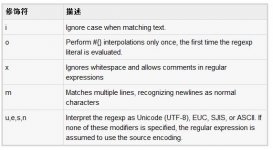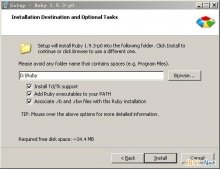Ruby是純面向對象的語言,所有項目似乎要Ruby中為一個對象。Ruby中的每個值是一個對象,即使是最原始的東西:字符串,數字甚至true和false。即使是一個類本身是一個對象,它是Class類的一個實例。本章將通過所有功能涉及到Ruby的面向對象。
類是用來指定對象的形式,它結合了數據表示和方法操縱這些數據,轉換成一個整齊的包。在一個類的數據和方法,被稱為類的成員。
Ruby類的定義:
定義一個類,定義的數據類型的草圖。 這實際上并不定義任何數據,但它定義的類名字的意思什么,即是什么類的對象將包括這樣一個對象上執行什么操作可以。
類定義開始與關鍵字class類名和 end 分隔。例如,我們定義Box類使用class關鍵字如下:
class Box
code
end
名稱必須以大寫字母開始,按照約定名稱中包含多個單詞,每個單詞沒有分隔符(駝峰式)一起執行。
定義Ruby的對象:
類為對象的藍圖,所以基本上是一個從一個類對象被創建。我們聲明一個類的對象使用new關鍵字。下面的語句聲明了兩個對象,Box 類:
|
1
2
|
box1 = Box.newbox2 = Box.new |
initialize方法:
initialize方法是一個標準的Ruby類的方法,和其它面向對象編程語言的構造方法有相同的方式工作。 initialize方法是有用的,在創建對象的時候,一些類變量初始化。這種方法可能需要的參數列表,它像其他Ruby之前的方法用def關鍵字定義,如下所示:
class Box
def initialize(w,h)
@width, @height = w, h
end
end
實例變量:
實例變量是類的一種屬性,一旦我們使用的類對象被創建的對象的屬性。每個對象的屬性被分別賦值的并與其它對象共享,它們在類的內部使用@操作符訪問,但訪問類之外的,我們使用的公共方法被稱為訪問器方法。如果我們把上述定義的類 Box,然后 @width 和 @height 類 Box實例變量。
|
1
2
3
4
5
6
|
class Box def initialize(w,h) # assign instance avriables @width, @height = w, h endend |
訪問器和setter方法:
為了外部能訪問類的變量,它們必須定義存取器方法,這些存取器方法也被稱為getter方法。下面的例子演示了如何使用訪問器方法:
|
1
2
3
4
5
6
7
8
9
10
11
12
13
14
15
16
17
18
19
20
21
22
23
24
25
26
27
28
|
#!/usr/bin/ruby -w# define a classclass Box # constructor method def initialize(w,h) @width, @height = w, h end # accessor methods def printWidth @width end def printHeight @height endend# create an objectbox = Box.new(10, 20)# use accessor methodsx = box.printWidth()y = box.printHeight()puts "Width of the box is : #{x}"puts "Height of the box is : #{y}" |
當上面的代碼執行時,它會產生以下結果:
|
1
2
|
Width of the box is : 10Height of the box is : 20 |
類似的存取方法用于訪問的變量值,Ruby提供了一種方法來從類的外部設置這些變量的值,那就是setter方法??,定義如下:
|
1
2
3
4
5
6
7
8
9
10
11
12
13
14
15
16
17
18
19
20
21
22
23
24
25
26
27
28
29
30
31
32
33
34
35
36
37
38
39
|
#!/usr/bin/ruby -w# define a classclass Box # constructor method def initialize(w,h) @width, @height = w, h end # accessor methods def getWidth @width end def getHeight @height end # setter methods def setWidth=(value) @width = value end def setHeight=(value) @height = value endend# create an objectbox = Box.new(10, 20)# use setter methodsbox.setWidth = 30box.setHeight = 50# use accessor methodsx = box.getWidth()y = box.getHeight()puts "Width of the box is : #{x}"puts "Height of the box is : #{y}" |
當上面的代碼執行時,它會產生以下結果:
|
1
2
|
Width of the box is : 30Height of the box is : 50 |
實例方法:
也以同樣的方式,因為我們使用def關鍵字定義其他方法,并按下圖所示僅對使用一個類的實例,它們可以被用來定義該實例方法。它們的功能不局限于訪問實例變量,他們也可以按要求做更多的事情。
|
1
2
3
4
5
6
7
8
9
10
11
12
13
14
15
16
17
18
19
20
|
#!/usr/bin/ruby -w# define a classclass Box # constructor method def initialize(w,h) @width, @height = w, h end # instance method def getArea @width * @height endend# create an objectbox = Box.new(10, 20)# call instance methodsa = box.getArea()puts "Area of the box is : #{a}" |
當上面的代碼執行時,它會產生以下結果:
|
1
|
Area of the box is : 200 |
類的方法和變量:
類變量是一個變量,這是一個類的所有實例之間共享。該變量是一個實例,它是可訪問對象實例。兩個@字符類變量帶有前綴(@@)。在類定義類變量必須初始化,如下所示。
類方法的定義使用:def self.methodname() 以 end 字符結束,將被稱為使用classname.methodname類名,在下面的例子所示:
|
1
2
3
4
5
6
7
8
9
10
11
12
13
14
15
16
17
18
19
20
21
22
23
|
#!/usr/bin/ruby -wclass Box # Initialize our class variables @@count = 0 def initialize(w,h) # assign instance avriables @width, @height = w, h @@count += 1 end def self.printCount() puts "Box count is : #@@count" endend# create two objectbox1 = Box.new(10, 20)box2 = Box.new(30, 100)# call class method to print box countBox.printCount() |
當上面的代碼執行時,它會產生以下結果:
|
1
|
Box count is : 2 |
to_s 方法:
所定義的任何類的實例應該有一個 to_s 方法返回一個字符串形式表示對象。下面以一個簡單的例子來表示一個Box對象,在寬度和高度方面:
|
1
2
3
4
5
6
7
8
9
10
11
12
13
14
15
16
17
18
|
#!/usr/bin/ruby -wclass Box # constructor method def initialize(w,h) @width, @height = w, h end # define to_s method def to_s "(w:#@width,h:#@height)" # string formatting of the object. endend# create an objectbox = Box.new(10, 20)# to_s method will be called in reference of string automatically.puts "String representation of box is : #{box}" |
當上面的代碼執行時,它會產生以下結果:
|
1
|
String representation of box is : (w:10,h:20) |
訪問控制:
Ruby提供了三個級別的保護實例方法的級別:public, private 和 protected。 Ruby沒有應用實例和類變量的任何訪問控制權。
- Public Methods: 任何人都可以被稱為public方法。方法默認為公用初始化,這始終是 private 除外。 .
- Private Methods: private方法不能被訪問,或者甚至從類的外部瀏覽。只有類方法可以訪問私有成員。
- Protected Methods: 受保護的方法可以被調用,只能通過定義類及其子類的對象。訪問保存在類內部。
以下是一個簡單的例子來說明三個訪問修飾符的語法:
|
1
2
3
4
5
6
7
8
9
10
11
12
13
14
15
16
17
18
19
20
21
22
23
24
25
26
27
28
29
30
31
32
33
34
35
36
37
38
39
40
41
42
|
#!/usr/bin/ruby -w# define a classclass Box # constructor method def initialize(w,h) @width, @height = w, h end # instance method by default it is public def getArea getWidth() * getHeight end # define private accessor methods def getWidth @width end def getHeight @height end # make them private private :getWidth, :getHeight # instance method to print area def printArea @area = getWidth() * getHeight puts "Big box area is : #@area" end # make it protected protected :printAreaend# create an objectbox = Box.new(10, 20)# call instance methodsa = box.getArea()puts "Area of the box is : #{a}"# try to call protected or methodsbox.printArea() |
當上面的代碼被執行時,產生下面的結果。在這里,第一種方法被調用成功,但第二種方法給一個提示。
|
1
2
3
|
Area of the box is : 200test.rb:42: protected method `printArea' called for #<Box:0xb7f11280 @height=20, @width=10> (NoMethodError) |
類的繼承:
在面向對象的編程中最重要的概念之一是繼承。繼承允許我們定義一個類在另一個類的項目,這使得它更容易創建和維護應用程序。
繼承也提供了一個機會,重用代碼的功能和快速的實現時間,但不幸的是Ruby不支持多級的繼承,但Ruby支持混入。一個mixin繼承多重繼承,只有接口部分像一個專門的實現。
當創建一個類,而不是寫入新的數據成員和成員函數,程序員可以指定新的類繼承現有類的成員。這種現有的類稱為基類或父類和新類稱為派生類或子類。
Ruby也支持繼承。繼承和下面的例子解釋了這個概念。擴展類的語法很簡單。只需添加一個<字符的超類聲明的名稱。例如,定義Box類的子類classBigBox:
|
1
2
3
4
5
6
7
8
9
10
11
12
13
14
15
16
17
18
19
20
21
22
23
24
25
26
27
28
29
|
#!/usr/bin/ruby -w# define a classclass Box # constructor method def initialize(w,h) @width, @height = w, h end # instance method def getArea @width * @height endend# define a subclassclass BigBox < Box # add a new instance method def printArea @area = @width * @height puts "Big box area is : #@area" endend# create an objectbox = BigBox.new(10, 20)# print the areabox.printArea() |
當上面的代碼執行時,它會產生以下結果:
|
1
|
Big box area is : 200 |
方法重載:
雖然可以在派生類中添加新的函數,但有時想改變的行為已經在父類中定義的方法。只需通過保持相同的方法名和重寫該方法的功能,如下圖所示,在這個例子可以這樣做:
|
1
2
3
4
5
6
7
8
9
10
11
12
13
14
15
16
17
18
19
20
21
22
23
24
25
26
27
28
29
|
#!/usr/bin/ruby -w# define a classclass Box # constructor method def initialize(w,h) @width, @height = w, h end # instance method def getArea @width * @height endend# define a subclassclass BigBox < Box # change existing getArea method as follows def getArea @area = @width * @height puts "Big box area is : #@area" endend# create an objectbox = BigBox.new(10, 20)# print the area using overriden method.box.getArea() |
運算符重載:
我們想“+”運算符使用+,*操作由一個標量乘以一箱的寬度和高度,這里是一個版Box類的定義及數學運算符:
|
1
2
3
4
5
6
7
8
9
10
11
12
13
14
15
16
17
|
class Box def initialize(w,h) # Initialize the width and height @width,@height = w, h end def +(other) # Define + to do vector addition Box.new(@width + other.width, @height + other.height) end def -@ # Define unary minus to negate width and height Box.new(-@width, -@height) end def *(scalar) # To perform scalar multiplication Box.new(@width*scalar, @height*scalar) endend |
凍結對象:
有時候,我們要防止被改變的對象。凍結對象的方法可以讓我們做到這一點,有效地把一個對象到一個恒定。任何對象都可以被凍結通過調用Object.freeze。不得修改凍結對象:不能改變它的實例變量。
可以使用Object.frozen?語句檢查一個給定的對象是否已經被凍結,被凍結的情況下的對象語句方法返回true,否則返回false值。下面的示例 freeze 的概念:
|
1
2
3
4
5
6
7
8
9
10
11
12
13
14
15
16
17
18
19
20
21
22
23
24
25
26
27
28
29
30
31
32
33
34
35
36
37
38
39
40
41
42
43
44
45
46
47
|
#!/usr/bin/ruby -w# define a classclass Box # constructor method def initialize(w,h) @width, @height = w, h end # accessor methods def getWidth @width end def getHeight @height end # setter methods def setWidth=(value) @width = value end def setHeight=(value) @height = value endend# create an objectbox = Box.new(10, 20)# let us freez this objectbox.freezeif( box.frozen? ) puts "Box object is frozen object"else puts "Box object is normal object"end# now try using setter methodsbox.setWidth = 30box.setHeight = 50# use accessor methodsx = box.getWidth()y = box.getHeight()puts "Width of the box is : #{x}"puts "Height of the box is : #{y}" |
當上面的代碼執行時,它會產生以下結果:
|
1
2
3
|
Box object is frozen objecttest.rb:20:in `setWidth=': can't modify frozen object (TypeError) from test.rb:39 |
類常量:
可以在類里定義分配一個直接的數字或字符串值,而不使用其定義一個變量為@@ 或 @。按照規范,我們保持常量名大寫。
一個常量一旦被定義就不能改變它的值,但可以在類里像常量一樣直接訪問,但如果要訪問一個類之外的常量,那么要使用類名::常量,所示在下面的例子。
|
1
2
3
4
5
6
7
8
9
10
11
12
13
14
15
16
17
18
19
20
21
22
23
24
|
#!/usr/bin/ruby -w# define a classclass Box BOX_COMPANY = "TATA Inc" BOXWEIGHT = 10 # constructor method def initialize(w,h) @width, @height = w, h end # instance method def getArea @width * @height endend# create an objectbox = Box.new(10, 20)# call instance methodsa = box.getArea()puts "Area of the box is : #{a}"puts Box::BOX_COMPANYputs "Box weight is: #{Box::BOXWEIGHT}" |
當上面的代碼執行時,它會產生以下結果:
|
1
2
3
|
Area of the box is : 200TATA IncBox weight is: 10 |
類常量繼承和實例方法一樣,可以覆蓋。
創建對象使用分配:
當創建一個對象,而不調用它的構造函數初始化,即可能有一個情況:采用 new 方法,在這種情況下可以調用分配,這將創造一個未初始化的對象,看下面的例子:
|
1
2
3
4
5
6
7
8
9
10
11
12
13
14
15
16
17
18
19
20
21
22
23
24
25
26
27
28
29
30
|
#!/usr/bin/ruby -w# define a classclass Box attr_accessor :width, :height # constructor method def initialize(w,h) @width, @height = w, h end # instance method def getArea @width * @height endend# create an object using newbox1 = Box.new(10, 20)# create another object using allocatebox2 = Box.allocate# call instance method using box1a = box1.getArea()puts "Area of the box is : #{a}"# call instance method using box2a = box2.getArea()puts "Area of the box is : #{a}" |
當上面的代碼執行時,它會產生以下結果:
|
1
2
3
4
5
|
Area of the box is : 200test.rb:14: warning: instance variable @width not initializedtest.rb:14: warning: instance variable @height not initializedtest.rb:14:in `getArea': undefined method `*' for nil:NilClass (NoMethodError) from test.rb:29 |
類信息:
如果類定義的可執行代碼,這意味著他們在執行的上下文中一些對象:自身都必須引用的東西。讓我們來看看它是什么。
|
1
2
3
4
5
6
7
|
#!/usr/bin/ruby -wclass Box # print class information puts "Type of self = #{self.type}" puts "Name of self = #{self.name}"end |
當上面的代碼執行時,它會產生以下結果:
|
1
2
|
Type of self = ClassName of self = Box |
這意味著,一個類的定義,作為當前對象的類并執行。在元類和其超類的方法將在執行過程中使用的方法定義。




